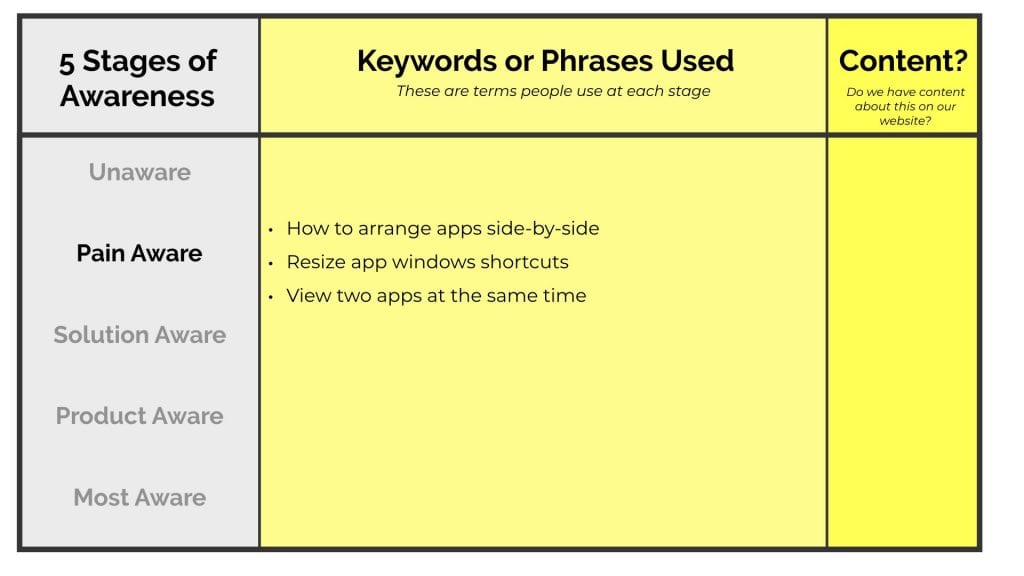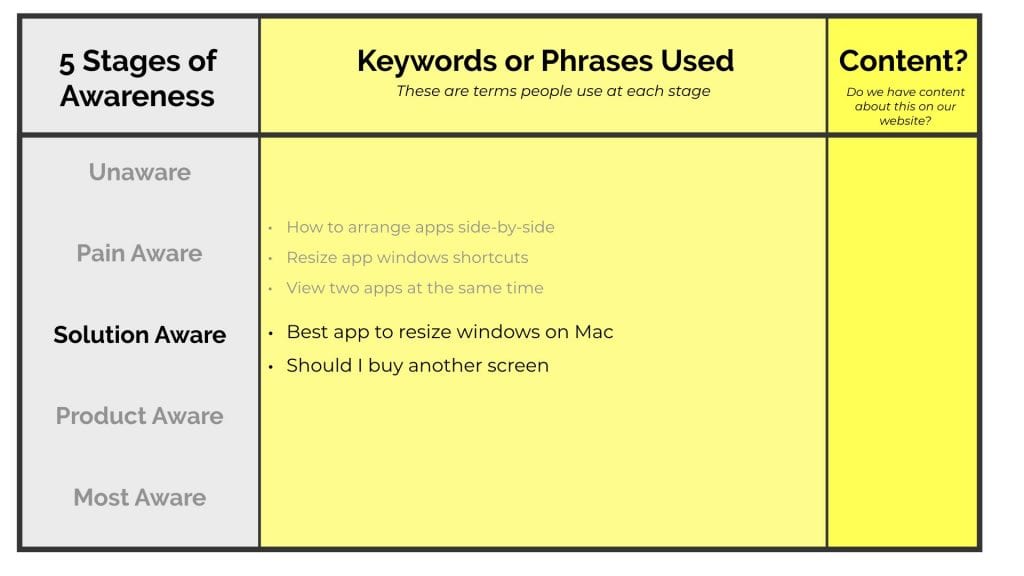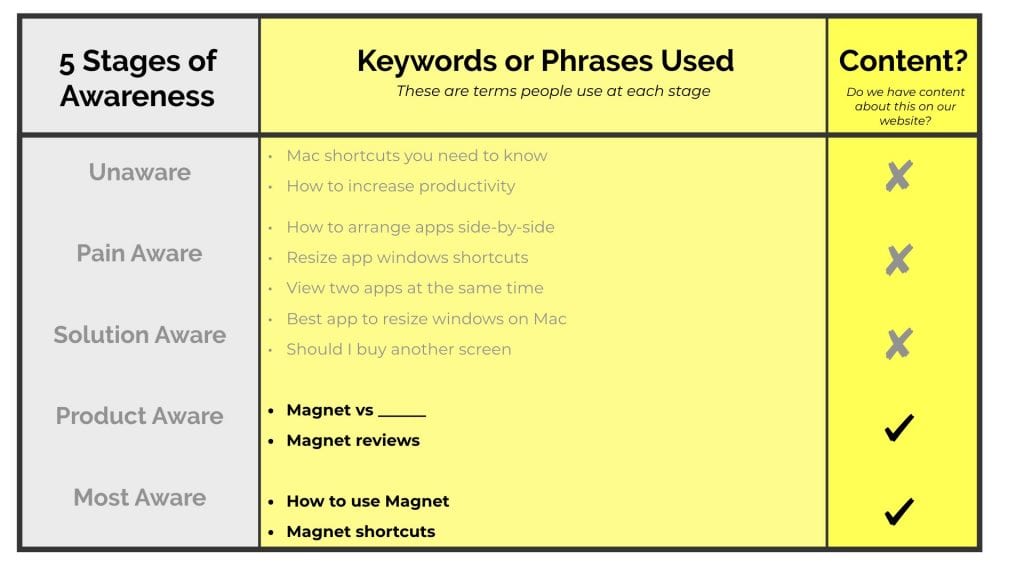You know that without a holistic strategy behind your entire digital marketing, you will not achieve great results.
You also know that content should be at the heart of every digital marketing campaign.
This is also supported by the saying, “If you are not found online, you do not exist” because without content, you will not rank for anything.
And one of the most effective frameworks for creating content is the 5 stages of awareness.
If you’re looking for more information on how to use it, you’re in the right place.
How to Use the 5 Stages of Awareness to Create Your Content Strategy
If you Google “content strategy,” you’ll get millions of results. That just proves how vital creating content is in today’s hyper competitive markets.
Regardless of which one you look at, the best strategy is the one that affects your bottomline. Your profits. Your customers. Your leads.
If all the content strategy talks about is to increase your traffic, stop reading that now. That’s useless. You don’t want traffic. You want more leads and more customers.
Also, an effective content strategy goes beyond customer acquisition. It also includes customer retention and support.
That’s the main reason why it has to be holistic strategy and not just address one part of the equation.
With that out of the way, let’s get started.
Step 1: Decide on one product/service
Start with one product/service that you want to focus on for this quarter.
It can be anything — a major initiative from management; a new product you want to launch; or simply something you want to because you believe in it so much.
Once you decide on which one to focus on, proceed to the next step.
Step 2: Create a table with the 5 stages of awareness as individual rows
If you haven’t already, you can review the 5 stages of awareness here.
At this step, just take out your notebook or open up a spreadsheet and create a table that looks like this…

Step 3: Add keywords or phrases used for each stage
The next step is to add keywords or phrases people use at each stage. For example, for people who are unaware of your company and brand, what do they search for online? What do they ask their friends?
Example: Magnet App
It easier to explain this with an example. So, I’ll use an app that I absolutely love. It’s called Magnet. If you have a Mac, you can download Magnet here (and no, that’s not an affiliate link — I just love them).
It’s very simple and only does one thing: resize and/or align the current window (or app) to a certain preset without the need to move your cursor to a corner and drag it to the size you want. This is great for working on two apps at the same time like a writing document on one side then a browser on the other.
Keywords or phrases people use
Getting started with this is difficult for most people because they are so used to only thinking about the product aware and most aware stages. For a quick recap, here are the 5 stages of awareness again:
- Unaware — those who aren’t aware they have a problem, and therefore, don’t need anything
- Pain Aware — people who are experiencing problems or issues but not any solutions
- Solution Aware — those who know they have a problem and potential solutions available
- Product Aware — people who know you offer the solutions they may need but have yet to choose your offer
- Most Aware — those who know you and trust you
The key mindset to get into is this…
What keywords or phrases do people use when ____________.
For example, ask yourself this question: what keywords or phrases do people use when they are experiencing problems or issues, but don’t know a particular solution or brand yet? (👈 Stage 2: Pain Aware)

Or let’s say you want to focus on stage 3 – solution aware.
What keywords or phrases do people use when they are aware they need something to increase their productivity but haven’t heard of you and your brand yet.

Then, just continue with the table until you fill it all out.
Step 4: Map your existing content
At this point, if you’re like most businesses, you probably don’t have content at stages 1 to 3. And that’s okay.
You most likely only have content in the product aware and most aware stages.

But the great part is now, you are aware of the opportunities you are missing out. More importantly, your competitors are most likely doing the same thing. Since you know that there is a gap, you can take advantage of this.
Which brings us to the next step…
Step 5: Create content to fill the gap
Start with writing written content to fill the content gap — articles.
Why?
Because written content still has the highest chance for ranking on search engines (at least for now). Plus, it’s going to be the heart of everything you’ll be doing in the next step.
Follow the guidelines when creating content for the first time. Don’t worry about stuff you can’t control. Don’t worry about SEO.
Focus on your customers. Write your content with them in mind.
Once you finish this step, you are already 80% ahead of your competitors.
Step 6: Repurpose your content
Once you finished an article and posted it on your website’s blog, it’s now time to think of repurposing your content.
Repurposing your content means using it in some other way. If the original version is used as an article on your website, ask yourself how can it be used on other marketing channels?
Ask yourself how you would transform that original article into different formats:
- How would you send it to your email subscribers?
- How would you post it on social media?
- Can you make an infographic out of it?
- What about a video?
- Can you use that video on social media as well?
- What about adding the video to your blog too?
That’s the kind of thinking of you need to have after creating one piece of content so that it doesn’t go to waste.
Step 7: Distribute your content
While this may seem implicit, I found that a lot of people still believe that once you publish a content on your website, people will find it and get tons of traffic.
Sorry, but that’s not how it works.
Maybe 10 years ago when there weren’t as much competition online. But with more than 1.5 billion websites today (and counting), you have a lot indirect competitors (for their time and attention).
Today, you have to use an omni-channel approach when you distribute your content.
Post regularly and engage with your fans/followers.
Remember that consistency is more important than perfection.
Step 8: Analyze performance
Remember the 10,000-hour rule?
What that means, at its basic level, is that the more you do things, the better you get at it. But that’s under the assumption you’re doing it right. And that’s where analysis comes in.
Think of it as having a coach to tell you what you’re doing right and what you need to improve on further.
You can play the guitar for 2 hours a day, but if you’re not hitting the right cords — and you don’t know it — you won’t get any better.
Analyze your content’s performance. The most common tool marketers use is Google Analytics.
Step 9: Improve and repeat
After figuring out what works and what doesn’t in the previous step, you now have the data to improve. Without the information, you cannot improve.
That’s why it’s important for you to analyze your performance. And you cannot analyze your performance if you don’t perform.
This is actually one of the topics I’ll be writing more about. I found that most people, including me for a very long time, don’t want to do something because it’s not perfect. But that only makes things difficult.
As you already know, ideas are everywhere.
The real determining factor of success is execution.
Conclusion
Apart from the 5 stages of awareness, there are other tools to help you create higher quality content faster.
For example, you can use a content pillar approach where you create a big piece of content (the pillar), then repurpose it into smaller pieces.
And, if you follow my recommendation of a two-pronged content strategy, you can create content and get results quickly while you brainstorm and plan your content pillar.
And to make sure you’re creating content across the entire buyer’s journey, you can perform a content mapping exercise.
1 thought on “Use the 5 Stages of Awareness to Develop Your Content Strategy”
Practical tips. Do you have the same thing for the other stages of the funnel?